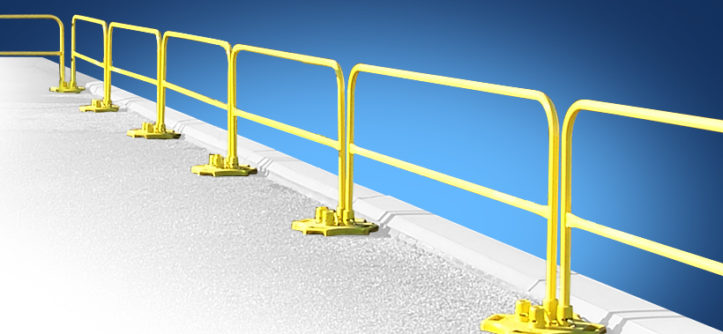Falling, especially falls from significant heights, is one of the main hazards that cause serious injuries and even death among workers.
Unprotected edges increase workers susceptibility to falling.
Moreover, it is important to note that the risk of serious injuries and even death increases with an increase in height.
If working at significant heights is part of the job, workers should use solid platforms such as scaffolds.
Guard Rails Edge Protection
To increase the overall protection of workers, the edge protection must be incorporated into every work platform with an open edge.
To this end, scaffold platforms must incorporate suitable edge protection systems in the form of toeboards and double guardrails.
These will protect workers from falling. Additionally, these features will prevent materials from falling.
For roof edges, the main consideration is sturdiness; the scaffold design should be sturdy enough to withstand the force of someone falling.
However, other factors such as the roof pitch, the roof surface, and the total length of the roof edge to the top ridge should be considered when designing the scaffold.
That said, every access and working platform should have full edge protection with features such as mid-rail, toeboard, handrail, and brick guard.
Guard rails are effective at protecting workers from falling in the following circumstances:
- The perimeter of a building or any other structure,
- The perimeter of skylights or any other fragile roofing material,
- Any openings in the roof structure or floor, and
- The edges of an excavation site.
Guard Rail Components
Guard railing must:
- Have a top rail installed 900mm-1100mm above the working surface
- Have a mid-rail, a toe-board (with the exception being where it is impractical to install them) and alternative control
- Have safety measures, such as ‘no go’ zones, to negate any risk to workers from falling objects when erecting the scaffolding.
- Be robustly designed and constructed, in strict accordance with all the relevant Australian Standards.
Top Rails
Top rails must be installed 900mm – 1100mm above all the working surface.
Mid Rails
Mid-rails must be installed. Alternatively, a wire mesh guard incorporated into the toe board can be used instead of the mid-rail.
Toe-boards should be installed where practical.
The combination of mid-rails and mesh guards negate the chances of the workers or objects sliding off the roof.
Toe Boards
In the absence of mesh guard rails, the combination of a mid-rail and a toe-boards must be used.
Catch Deck
When setting up a catch deck, the fall distance between the working surface and the deck should not exceed 1 meter.
When setting up the deck for access to a working surface, the maximum fall distance should not exceed 300mm.
When the roof pitch exceeds 25 degrees, the catch deck should not exceed a maximum 300mm below the working surface, which is the roof.
Roof pitches that exceed 35 degrees should have a platform installed at the same level as the working surface.
Alternatively, you could install the mesh guard and handrail a maximum of 100mm laterally from the leading edge, which is the slab edge or the gutter.
Roof Pitch 25-35 Degrees
When the pitch of the roof ranges between 26 and 35 degrees, the platform should be installed to minimise the likelihood of a worker falling over the guardrail system or falling on the top rail.
Additionally, the platform should be at least 450mm side – at least 2 scaffolds planks wide – and it should have infill panels and guardrails on the outside of the perimeter.Roof Pitch Exceeding 35 Degrees
When the pitch of the roof exceeds 35 degrees, a risk assessment should be done to identify any additional safeguards to incorporate.
Additional protection measures may include installing edge protection on the inside of the roof not more than 100mm from the edge (from the gutter).
SCAFFOLD CONSTRUCTION – ALWAYS FOLLOW THE 1m RULE UNLESS WEARING A HARNESS, NO EXCEPTIONS
Edge protection systems including mid-rails, handrails, and toe-boards must be installed on all open edges of a work platform.
There should be no access above any penetrations in scaffolds.
Should workers have to work above the scaffold penetrations, the penetrations should be covered and secure.
Alternatively, the guardrails system should be installed to prevent workers from accessing the penetrations.
The workers involved in the process of covering and securing or installing the railings above 2 meters should be harnessed with lanyards.
Before handballing (passing scaffold items) ensure all the platforms have a guardrail protecting all the leading edges where a worker can fall from a height of more than 2 meters.
If you are looking for knowledgeable and experienced scaffolders, who have leading-hands that work together with you and offer expert advice, please contact us at Skelscaff today on 1300 266 607 or email us at contact@skelscaff.com.au.
Tags: Guard Rails Edge Protection, scaffold platforms
